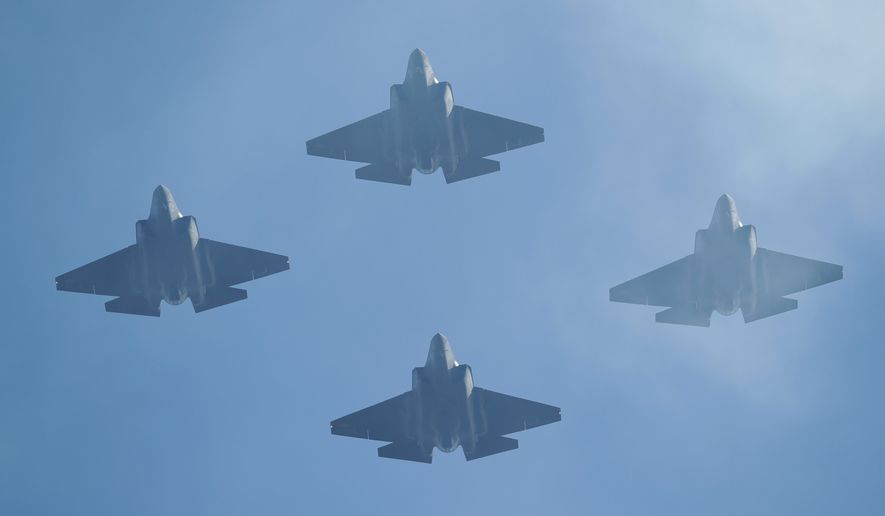Lawmakers turned their fire on the Pentagon’s troubled F-35 Joint Strike Fighter program Thursday, telling lead contractor Lockheed Martin and other stakeholders that they may pull the financial plug soon on the next-generation fighter jet unless they see dramatic production and performance improvements.
Thursday’s joint hearing before two key House subcommittees underscored the rising bipartisan unhappiness over the F-35 program, the Pentagon’s massive $1.7 trillion effort to build the aircraft of the future that could work equally well for the U.S. Air Force, the Marine Corps, and the Navy.
The program has been dogged by major cost overruns, delays and technical problems. While undeniably a technical marvel capable of conducting combat, surveillance, and a host of other missions, Thursday’s hearing was the latest sign that the F-35 is quickly falling out of favor on Capitol Hill.
“I’m going to take a deep breath and try to contain my anger at what is going on here,” Rep. John Garamendi, California Democrat, said. “The F-35 is the most expensive program in the history of the Department of Defense … The program is over budget, it fails to deliver on promised capabilities, and its mission capability rates do not even begin to meet the service thresholds.”
“The easy days of the past are over,” said Mr. Garamendi, who chairs the House Armed Services subcommittee on readiness. “Don’t expect more money. Do not expect to have more planes purchased than authorized in the president’s budget [this year]. That’s not going to happen.”
The idea of scaling back or even canceling the F-35 joint strike fighter program would’ve seemed unthinkable just a few years ago. The aircraft was intended to form the backbone of U.S. air power for years to come, and the Pentagon had planned to ultimately purchase as many as 2,500 planes over the coming decades.
There are about 400 F-35s flying right now, officials said Thursday. That figure includes planes in the American military and allied countries who also have also invested heavily in the aircraft.
If the program continues on its planned path, the cost of buying and maintaining the F-35 fleet over the plane’s lifespan is estimated to be as high as $1.7 trillion. The price tag keeps growing, however, prompting critics to charge that taxpayers are being fleeced as they continue to fund an aircraft that is incapable of delivering on all of its promises.
Lockheed Martin acknowledges there have been problems with the program, but insist the F-35 is still an irreplaceable part of the U.S. military moving forward. Officials with the leading defense contractor also say they’re working around the clock to address issues with the plane.
“Lockheed Martin is applying the full weight of our talent and our ingenuity to root out F-35 sustainment costs,” Greg Ulmer, executive vice president of aeronautics at the company, said Thursday.
Despite those reassurances — and the insistence by many analysts in the aerospace community that the F-35 is the gold standard of military aircraft, Congress is quickly losing patience.
House Armed Services Committee Chairman Adam Smith, Washington state Democrat, said earlier this year that the F-35 has become a “rathole” of endless spending, and that argued it was time to move on.
Republicans generally have been a bit more lenient toward the F-35, but even prominent voices in the GOP say the status quo isn’t acceptable.
“Getting it done right has been a struggle for both the [Department of Defense] and private industry,” said Missouri Rep. Vicky Hartzler, ranking Republican on the tactical air and land forces subcommittee.
A recent Government Accountability Office (GAO) report found that the F-35’s “Block 4” modernization program — part of the effort to keep the aircraft fully updated — has grown by $1.9 billion since 2019. The modernization push will now extend to 2027, a year longer than initially expected.
COVID-19 also has disrupted supply chains, officials said, making it more difficult to get vital parts. GAO officials also told lawmakers Thursday that they’ve heard F-35 units across the military describe parts of the plane’s operating system as “difficult to use” and “prone to error.”
Ending the program entirely is virtually impossible given the massive amount of money already committed and the host of partnerships between the Pentagon and allies abroad. But lawmakers said they’re ready to look at alternatives.
“We don’t have unlimited resources,” said Rep. Donald Norcross, New Jersey Democrat and chairman of the tactical air and land forces panel. “I would not support any requests for additional aircraft beyond what is contained in this year’s presidential budget request.”
This year’s White House budget calls for another 97 F-35s.
• Ben Wolfgang can be reached at bwolfgang@washingtontimes.com.




Please read our comment policy before commenting.